Requirements and marking
Eye protection
- STANDARD EN 166:2001 (Personal eye protection)
- STANDARD EN 169:2002 (Filters for welding)
- STANDARD EN 170:2002 (Ultraviolet filters)
- STANDARD EN 171:2002 (Infrared filters)
- STANDARD EN 172:1994/A2:2001 (Sunglare filters for industrial use)
- STANDARD EN 167:2001 (Optical test methods)
- STANDARD EN 168:2001 (Non-optical test methods)
- STANDARD EN 207:2010 (Filters and eye-protectors against laser radiation)
- STANDARD EN 208:2009 (Eye-protectors for adjustment work on lasers and laser systems)
- STANDARD EN 1731:1997 (Mesh type eye and face protectors for industrial and non-industrial use against mechanical hazards and/or heat)
STANDARD EN 166:2001 (Personal Eye Protection)
This European standard specifies functional requirements for various types of personal eye-protectors. This standard is applicable to all types of individual eye protectors used against various hazards, such as those occurring in industry, laboratories, etc., which may cause eye injuries or vision impairment, with the exception of nuclear radiation, X-rays, lasers, and infrared radiation emitted by low-temperature sources.
The function of eye protectors is to provide protection against:
- Impacts of varying intensity
- Optical radiation
- Molten metals and hot solids
- Droplets and splashes
- Dust
- Gases
- Short-circuit electric arcs
Optional requirements are specified for additional features of eye protectors which, depending on the work, may be considered beneficial to the user.
- Resistance to surface damage by fine particles
- Eyewear's resistance to fogging
- Resistance to high infrared reflectance
- Protection against high-speed particles at extreme temperatures
This European Standard incorporates provisions from other publications, for reference.
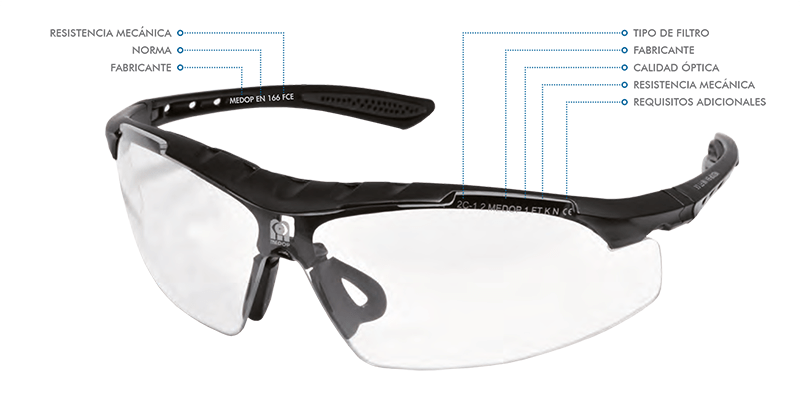
Marking
STANDARD EN 169:2002 (Filters for welding)
This European standard specifies the scale numbers and transmittance requirements for filters intended to protect operators performing work involving welding, braze-welding, arc gouging and plasma jet cutting. It also includes specifications for welding double-protection-class filters.

For the personal protection of the operator, the filter must be mounted in a suitable eye protector. For selecting the protection class of a filter for welding or related techniques, there are many factors involved:
- For flame welding and related techniques, such as copper brazing, this standard refers to the gas flow through the burners.
- For arc welding, air carbon arc gouging, and plasma cutting, the current intensity is an essential factor. For arc welding, the type of arc and the type of base metal must also be considered.
- Other parameters that are also influential but with effects that are difficult to assess:
- The position of the operator relative to the flame or arc.
- Ambient lighting.
- Human factors.
STANDARD EN 170:2002 (Ultraviolet filters)
This European Standard specifies the scale numbers and transmittance requirements for filters for protection against ultraviolet radiation.
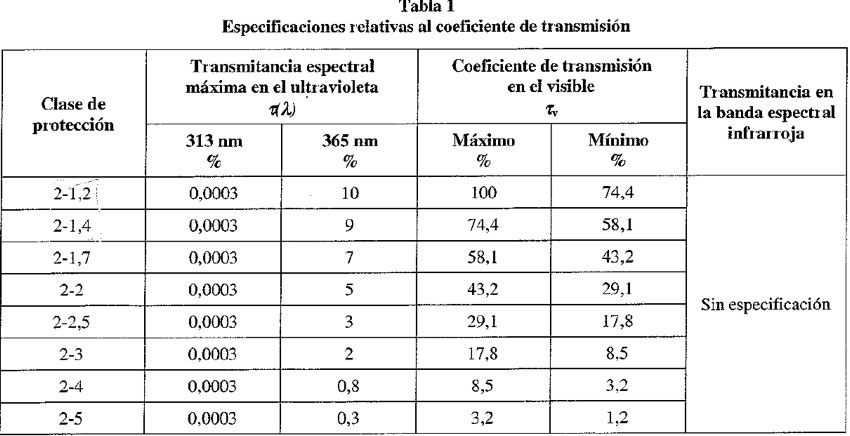

STANDARD EN 171:2002 (Infrared filters)
This European Standard specifies the scale numbers and transmittance requirements for filters for protection against infrared radiation.
The protection class of infrared filters consists of code 4 plus the filter's degree of protection, from 1.2 to 10:
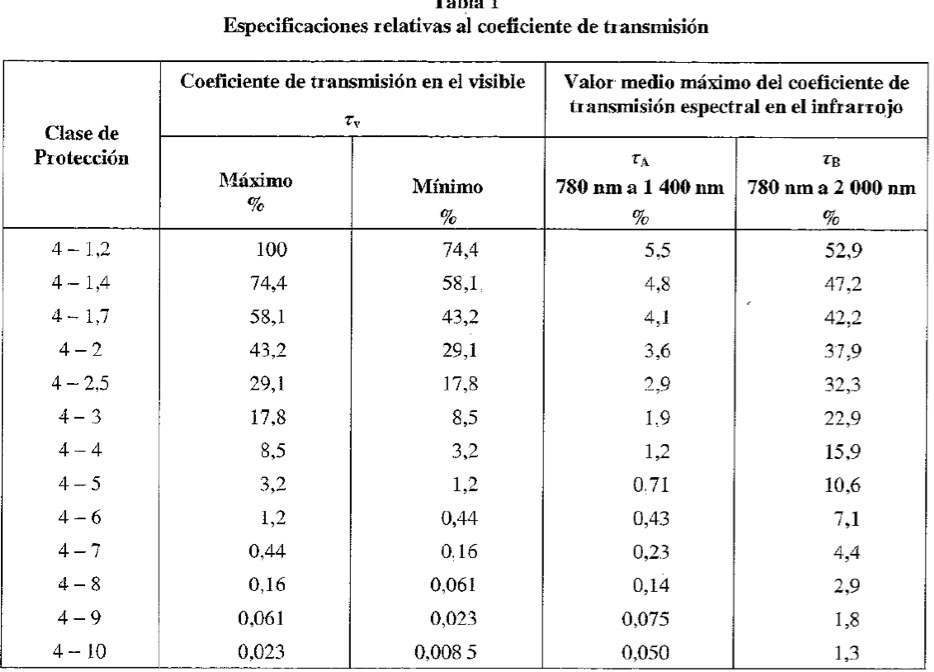
Infrared filters should protect the user from radiation while at the same time allowing a sufficient level of vision for the visual task at hand. Care must be taken to ensure that the colour coordinates of the filters are compatible with good colour recognition.
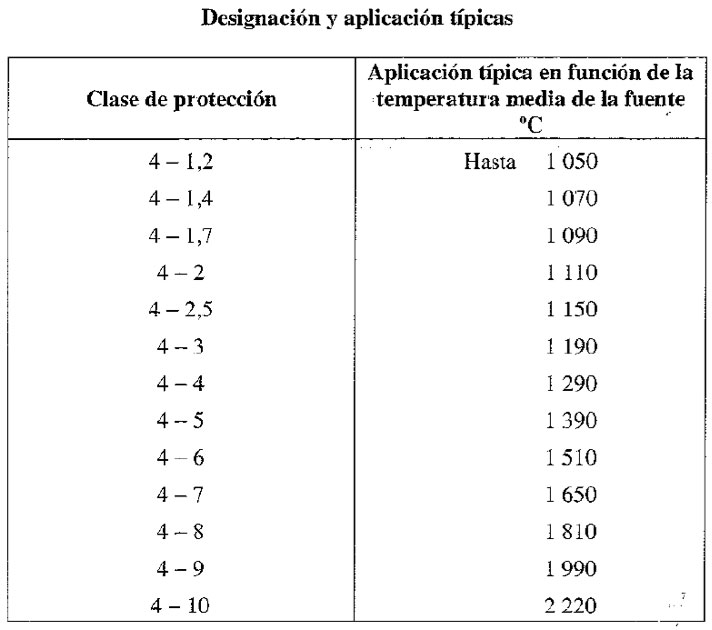
STANDARD EN 172:1994/A2:2001 (Sunglare filters for industrial use)
This European Standard specifies the scale numbers, transmittances and related requirements for sunglare filters for industrial use.
The scale number of a solar filter is constituted by the number 5 (filter with no requirement for infrared protection) or 6 (filter with a requirement for infrared protection), and the filter's degree of protection:
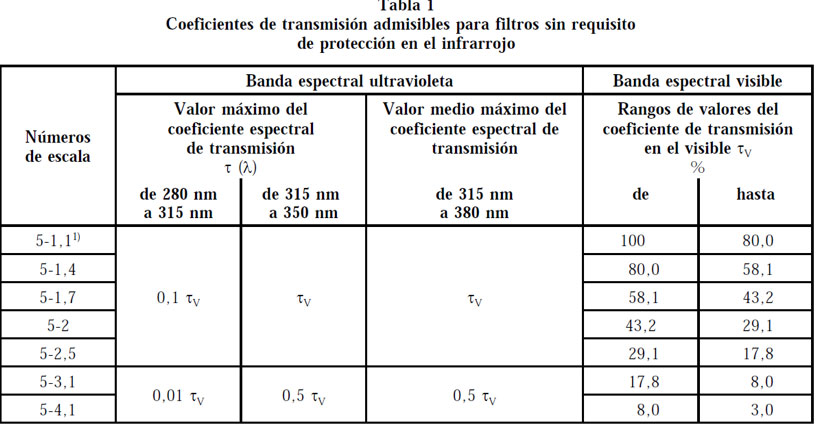
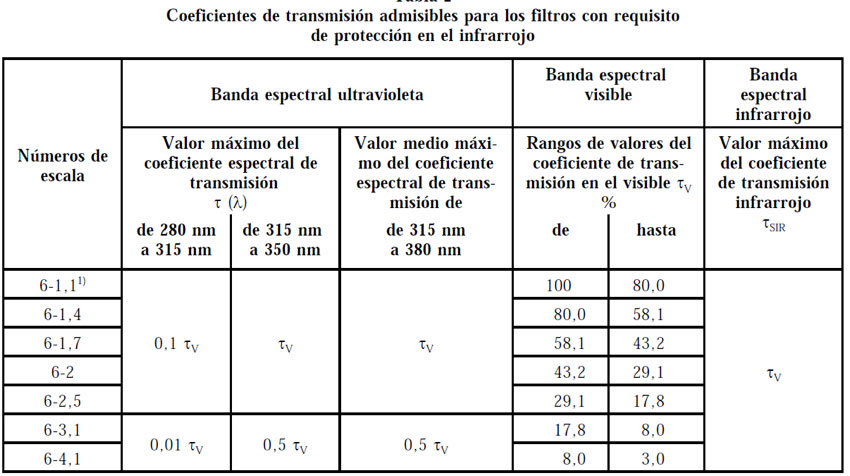
- Photochromic filters. The degrees of protection are determined by the transmission coefficient in the visible spectrum in the clear state (Ƭ0) and after radiation for 15 min (Ƭ1). For photochromic filters, Ƭ0/ Ƭ1 must be greater than or equal to 1.25.
- Polarising filters. Solar spectacles equipped with polarising filters must be mounted in such a way that the plane of polarisation does not deviate more than ±3% from the vertical orientation, or from the nominal direction if the two do not coincide.
- Gradient filters: The degrees of protection of gradient filters are determined by the lightest and darkest areas within a 15mm-radius circle around the geometric centre for unmounted filters, or the visual centre for mounted filters.
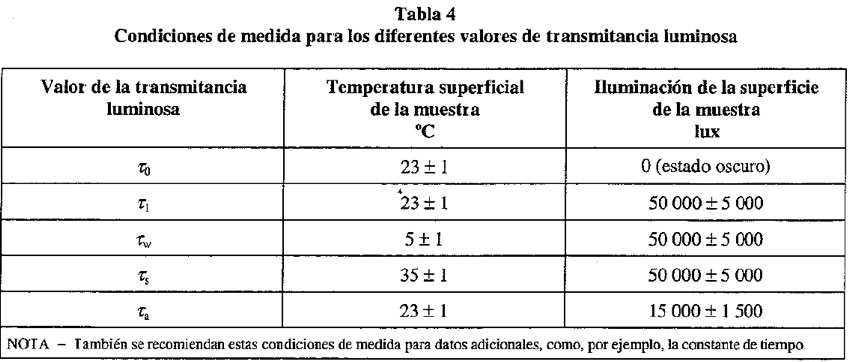
STANDARD EN 167:2001 (Optical test methods)
This European standard specifies optical test methods for eye-protectors, the requirements for which are contained in other EN's.
- Test for spherical, astigmatic and prismatic refractive powers. Two different tests: Testing unmounted oculars covering one eye. Testing unmounted oculars covering both eyes and mounted oculars (spectacles, goggles and face-shields).
- Light diffusion test There are different test methods: basic method and simplified method.
- Assessment of quality of material and surface.
- Determination of transmittance.
- Determination of variations in luminous transmittance. Tests performed: unmounted oculars covering one eye only, mounted oculars and unmounted oculars covering both eyes, and method to correct transmittance for variations in thickness of the ocular.
- Determination of spectral reflectance in infrared.
STANDARD EN 168:2001 (Non-optical test methods)
This European standard specifies non-optical test methods for eye-protectors, the requirements for which are contained in other European Standards.
- Test for increased robustness: for unmounted oculars, and for complete eye-protectors and frames.
- Test for minimum robustness of oculars with filtering effect and cover plates
- Test for stability at elevated temperature
- Test for resistance to ultraviolet radiation.
- Test for resistance to ignition.
- Test for resistance to corrosion.
- Test for resistance to high-speed particles and resistance to high speed particles at extremes of temperature.
- Test for protection against molten metals: test for non-adherence of molten metals, or test for area of coverage of face shields.
- Test for resistance to penetration by hot solids.
- Test for protection against droplets and liquid splashes: test for protection against droplets (for goggle type eye-protectors), test for protection against liquid splashes (for face-shields).
- Test for protection against large dust particles.
- Test for protection against gases and fine dust particles.
- Test for resistance to surface damage by fine particles.
- Test for resistance to fogging of oculars.
- Head-form.
- Assessment of field of vision.
- Assessment of lateral protection.
STANDARD EN 207:2010 (Filters and eye-protectors against laser radiation)
This European Standard applies to eye-protectors used for protection against accidental exposure to laser radiation as defined in EN 60825-1:2007 in the spectral range 180 nm (0,18 μm) to 1 000 μm. It defines the requirements, test methods and marking.
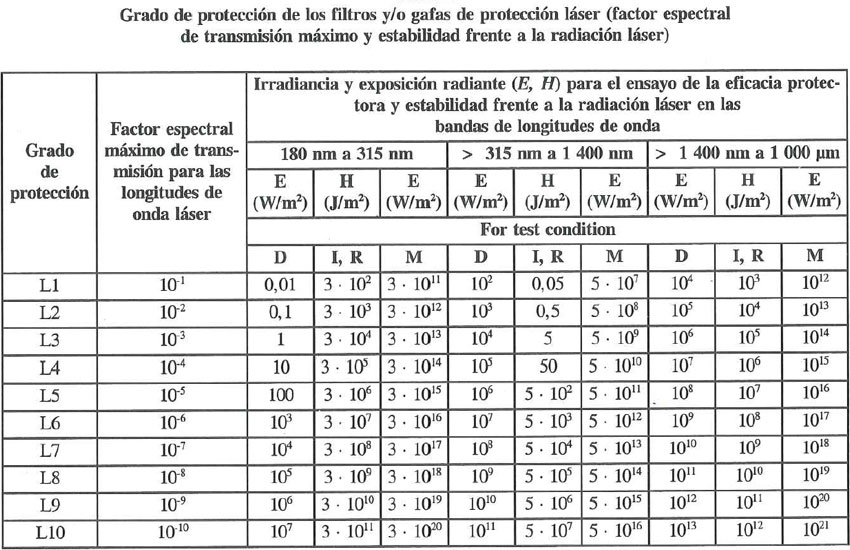
Marking: For identification purposes, the following data must be permanently marked on the frames or filters:
- The symbol for the test conditions.
- Wavelength or spectral band for which the filter provides protection.
- Degree of protection.
- Manufacturer's identification.
- Certification mark, if applicable.
- Whether the eye protection meets the mechanical strength requirements.
STANDARD EN 208:2009 (Eye-protectors for adjustment work on lasers and laser systems)
This European Standard applies to laser adjustment filters and eye-protectors. These are filters and eye-protectors for use in adjustment work on lasers and laser systems, where hazardous radiation occurs in the visible spectral range of 400 nm to 700 nm. Filters specified in this European Standard reduce this radiation to values defined for lasers of class 2 lasers).
This European Standard defines the requirements, test methods and marking.
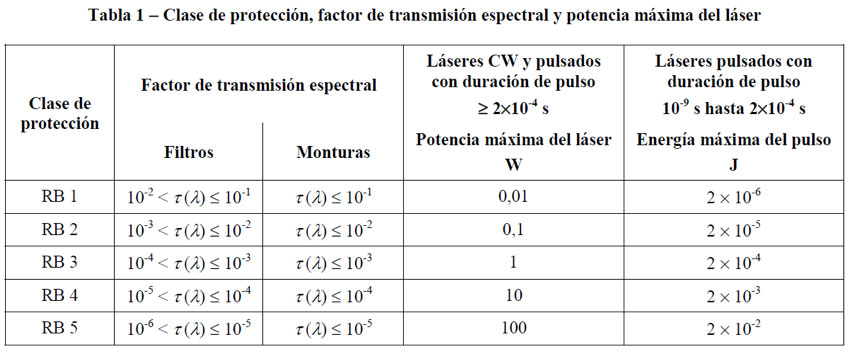
Marking: The following elements must be marked on the frames or filters for identification purposes:
- Maximum laser power in watts and maximum pulse energy in joules for which the filter provides protection.
- Wavelength or spectral band in nm for which the spectacle/eye protection is designed.
- The protection class.
- If the eye protector is not tested with a low repetition rate, the letter Y should be added after the protection class, e.g. RB5Y.
- The manufacturer's identification mark.
- Certification mark, if applicable.
- On the frame, the words “eye-protectors for adjustment work”.
- If the eye protection meets the mechanical strength requirements, one of the specific markings of EN 166:2001 must be added.
STANDARD EN 1731:1997 (Mesh type eye and face protectors for industrial and non-industrial use against mechanical hazards and/or heat)
This European Standard specifies materials, design, performance requirements, test methods and marking requirements for personal mesh eye protectors. This standard is not applicable to mesh eye protectors for protection against molten metal splash, hot solid risks, electrical hazard, infrared or ultraviolet radiations.
The material of the mesh eye and face shield must be: corrosion resistant, flame resistant, resistant to cleaning and disinfection products, a safe material, with a minimum of 15 cm2 covered in holes.
The marking of mesh eye and face shields must contain the following information:
- Manufacturer's identification.
- Standard number.
- Mechanical strength symbol.
Hearing protection
- STANDARD EN 352-2:2003 (Hearing protectors – Ear-plugs)
- STANDARD EN 352-1:2003 (Hearing protectors – Ear-muffs)
STANDARD EN 352-2:2003 (Hearing protectors – Ear-plugs)
The European Standard EN 352, “Hearing protectors – General requirements – Ear-plugs”, sets out the requirements for personal hearing protection equipment in relation to Directive 89/686/EEC on personal protective equipment.
The specific requirement related to the ability of hearing protectors to reduce noise below daily limits is considered in the standard, requiring that the acoustic attenuation of the hearing protector shall not be less than a certain minimum value. This part of the standard specifies constructional, design and performance requirements, marking requirements and user information for ear-plugs. In particular, it calls for the sound attenuation of the ear-plugs. The requirements of this standard are intended to take account of the ergonomic interaction between the wearer, the device and where possible the working environment in which the device is likely to be used. Includes disposable, reusable, customised, and headband earplugs.
The following information must be supplied with the earplugs:
- The number of this European Standard.
- The name, trademark, or other means of identification of the manufacturer.
- The model designation.
- If applicable, “this model of earplugs meets the optional -20°C requirement”.
- Headband materials.
- Placement and use instructions, which must indicate the need for appropriate fitting.
- Except for custom and semi-aural earplugs, the nominal diameter assignment and diameter range of the earplugs.
- For headband earplugs, the range of earplug sizes for each wearing mode.
- For each wearing mode, the acoustic attenuation values.
- The recommendation for the user to ensure that: the earplugs are fitted, adjusted, and maintained according to the manufacturer's instructions, and that the earplugs are worn permanently in noisy places. If the earplugs are reusable, regularly check their condition of use.
- A warning that, if the recommendations are not respected, the protection offered by the earplugs will be severely impaired.
- For earplugs that are attached with a cord, a warning that they should not be used where there is a risk that the cord might be snagged during use.
- If the earplugs are marked as reusable, cleaning and disinfection methods, and a notice to ensure the use of products that are known to not be harmful to users.
- Certain chemicals may have an adverse effect on these products. For further information, please contact the manufacturer.
- Recommended storage conditions.
- The average mass of the earplugs rounded to the nearest gram.
- The address where additional information can be obtained.
STANDARD EN 352-1:2003 (Hearing protectors – Ear-muffs)
This part of the standard specifies requirements for construction, design, performance, marking and user information for ear-muffs. In particular, it calls for the sound attenuation of the ear-muffs. This part of the standard does not deal with ear-muffs for attachment to a helmet or which are part of a helmet.
The following information must be supplied along with earmuffs:
- The number of this European Standard.
- The name, trademark, or identification of the manufacturer.
- The model designation.
- This model of earmuffs meets the optional requirements at +50°C or -2°C.
- Materials of the headband and ear cushions.
- Fitting/adjustment method.
- The range of earmuff sizes for each fitting mode.
- For each wearing mode, the acoustic attenuation values.
- The recommendation for the user to ensure that: the earmuffs are fitted, adjusted, and maintained according to the manufacturer's instructions, the earmuffs are worn permanently in noisy places, and that the earmuffs are checked regularly.
- A warning that, if the recommendations given are not followed, the protection offered by the earmuffs will be severely impaired.
- Cleaning and disinfection methods.
- Certain chemicals may have an adverse effect on this product. For more information, contact the manufacturer.
- The earmuffs, and particularly the ear cushions, may deteriorate with use; therefore, they should be examined periodically for cracks or leaks.
- The recommended conditions for storage and use.
- The designation and any other details for ordering replacement cushions.
- The method of cushion replacement.
- The average mass of the earmuffs.
- The address to contact for further information.
Respiratory protection
- STANDARD EN 140:1998 (Respiratory protective devices – Half masks and quarter masks)
- STANDARD EN 143:2000 (Respiratory protective devices – Particle filters)
- STANDARD EN 14387:2004 + A1:2008 (Respiratory protective devices – Gas filters and combined filters)
- STANDARD EN 405:2001+A1:2009 (Respiratory protective devices – Valved filtering half masks to protect against gases or gases and particles)
- STANDARD EN 136:1998 (Respiratory protective devices – Full face masks)
- STANDARD EN 149:2001 (Respiratory protective devices – Filtering half masks to protect against particles)
STANDARD EN 140:1998 (Respiratory protective devices – Half masks and quarter masks)
A particular item of respiratory protective equipment can only be approved when its individual components meet the requirements of the test specifications, and when the practical performance tests on the complete equipment have been successfully passed, these tests being specified in the relevant standard.
This European Standard specifies minimum requirements for half masks and quarter masks for use as part of respiratory protective devices, except escape apparatus and diving apparatus. Laboratory and practical performance tests are included for the assessment of compliance with the requirements.
A half mask is a facepiece that covers the nose, mouth, and chin. A quarter mask is a facepiece that covers the nose and mouth. Air enters the inside of the facepiece that covers the nose and mouth. The exhaled air is expelled directly to the environment by means of one/multiple exhalation valves.
Requirements to be met by all test samples:
- Ambient temperature should be 24-8°C and relative humidity should be 50-30%.
- Exposed parts should contain the least amount of aluminium, magnesium, titanium, or other metals.
- Temperature resistance.
- Flammability.
- Detachable components: they must connect easily.
- Replaceable components.
- Headband.
- Connector.
- Inhalation and exhalation valves.
- Skin-compatible materials.
- Resistance to breathing, not to exceed 2mbar for inhalation and 3mbar for exhalation when tested with a breathing machine.
- Inward leakage, not to exceed 5%.
- Field of vision.
- Practical performance.
Information to the user:
- Uses/limitations.
- Pre-use checks.
- Fitting and adjustment.
- How to use.
- Cleaning/disinfection.
- Maintenance.
- Storage.
- Expiry date.
- Warnings should be given on common problems that may arise.
STANDARD EN 143:2000 (Respiratory protective devices – Particle filters)
This European Standard specifies particle filters for use as components in unassisted respiratory protective devices with the exception of escape apparatus and filtering facepieces.
The air enters the particulate filter and passes into the facepiece after the particles have been removed. Filters are classified as follows: P1, P2 and P3 in ascending order of the filtering efficiency.
Filters must meet the following requirements for all tests on all samples:
- The ambient temperature for the test must be between 24-8°C, except for mechanical tests where a temperature between 20-10°C shall be used.
- Visual inspection.
- The connection must be strong and airtight.
- The maximum mass of the filter designed for using while directly connected to half masks is 300 g.
- Multiple filters, the complete set of filters integrated onto the device must meet all requirements. All necessary information on the use of multiple filters must be provided in the information supplied by the manufacturer.
- Materials, the filter must be manufactured to withstand normal use and exposure to temperatures, humidity, corrosive environments...
- Mechanical resistance, after the test, the filters must not show any damage.
- Thermal conditioning
- Resistance to breathing
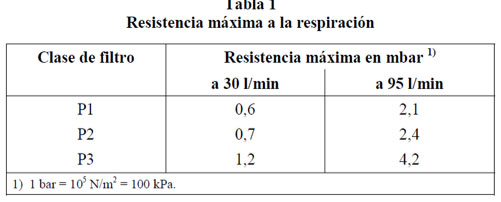
- Filter penetration

STANDARD EN 14387:2004 + A1:2008 (Respiratory protective devices – Gas filters and combined filters)
This European Standard refers to gas filters and combined filters for use as components in unassisted respiratory protective devices. Filters for use against CO are excluded from this standard.
Air enters through one or more gas filters or combination filters and passes into the facepiece after it removes gases and vapours, or gases, vapours, and particulates.
Types of filters:
A: For use against certain organic gases and vapours with a boiling point > 65 °C as specified by the manufacturer.
B: For use against certain inorganic gases and vapours as specified by the manufacturer.
E: For use against sulphur dioxide and other acidic gases and vapours as specified by the manufacturer.
K: For use against ammonia and organic ammonia derivatives as specified by the manufacturer.
AX: For use against certain organic gases and vapours with a boiling point ≤ 65 °C as specified by the manufacturer. For single use only.
SX: For use against specific named gases and vapours as specified by the manufacturer.
Multi-type gas filters: Filters which are a combination of two or more of the above types excluding type SX and which meet the requirements of each type separately.
Combined filters: Gas or multi-type gas filters incorporating a particle filter according to EN 143.
Gas filters of types A, B, E and K are classified in terms of capacity as follows:
- Class 1: Low capacity filters.
- Class 2: Medium capacity filters.
- Class 3: High capacity filters.

Gas and vapour filter markings by capacity
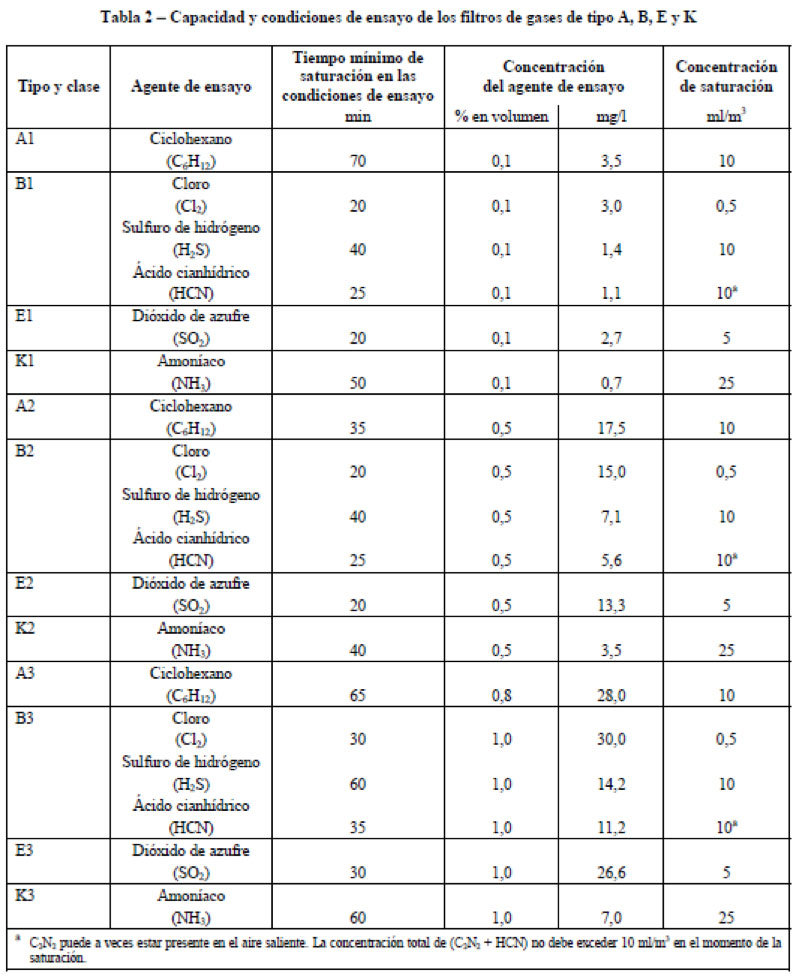
STANDARD EN 405:2001+A1:2009 (Respiratory protective devices – Valved filtering half masks to protect against gases or gases and particles)
This European Standard specifies the performance requirements, test methods and marking requirements for valved filtering half masks incorporating either gas or combined filters as respiratory protective devices except for escape purposes. It does not cover gas filtering half masks which do not have valves or are fitted only with exhalation valves.
A valved filtering half mask covers the nose and mouth and the chin and has both inhalation and exhalation valves. It consists entirely or substantially of filter material, or it comprises a facepiece in which the gas filter(s) form(s) an inseparable part of the device and where particle filters can be replaceable. The equipment is disposable; once the filter is saturated, it is not expected to provide exhalation components.
Types of gas filtering half masks:
- FFA: For use against certain organic gases and vapours with a boiling point higher than 65 °C as specified by the manufacturer.
- FFB: For use against certain inorganic gases and vapours as specified by the manufacturer.
- FFE: For use against sulphur dioxide and other acidic gases and vapours as specified by the manufacturer.
- FFK: For use against ammonia and organic ammonia derivatives as specified by the manufacturer.
- FFAX: For use against certain organic gases and vapours with a boiling point ≤ 65 °C as specified by the manufacturer. For single use only.
- FFSX: For use against specific named gases and vapours.
Marking: Filtering half masks with gas control valves and integrated particulate filters must be identified with the following information:
- Name, brand name of the manufacturer or supplier.
- Type identification marking.
- The type and appropriate class of the valved filtering half mask with an integrated particulate filter: "NR" if the particulate filter part is not reusable. "R" if the particulate filter part is reusable.
- If applicable, the letter "D" means that it meets the requirements of the clogging test, which must be part of the type and class designation.
- Sub-assemblies and components with considerable bearing on safety shall be marked.
- The use of colour coding is optional.
STANDARD EN 136:1998 (Respiratory protective devices – Full face masks)
This European Standard specifies minimum requirements for full face masks for respiratory protective devices.
A full face mask is a facepiece which covers the eyes, nose, mouth and chin. Air enters the full face mask through the connector(s) and passes directly to the nose and mouth area.
Three classes of full face masks are described, each providing the same level of respiratory protection but having some differences which reflect intended areas of application.
- Class 1: Full face masks for light duty use.
- Class 2: Full face masks for general use.
- Class 3: Full face masks for special use.
STANDARD EN 149:2001 (Respiratory protective devices – Filtering half masks to protect against particles)
This European Standard specifies minimum requirements for filtering half masks as respiratory protective devices to protect against particles except for escape purposes.
A particle filtering half mask covers the nose and mouth and the chin and may have inhalation and/or exhalation valve(s). The half mask consists entirely or substantially of filter material or comprises a facepiece in which the main filter(s) form an inseparable part of the device. It is intended to provide adequate sealing on the face of the wearer against the ambient atmosphere, when the skin is dry or moist and when the head is moved. Air enters the particle filtering half mask and passes directly to the nose and mouth area of the facepiece or, via an inhalation valve(s) if fitted. The exhaled air flows through the filter material and/or an exhalation valve (if fitted) directly to the ambient atmosphere. These devices are designed to protect against both solid and liquid aerosols.
Particle filtering half masks are classified according to their filtering efficiency and their maximum total inward leakage. There are three classes of devices: FFP1, FFP2 and FFP3.

Head protection
- STANDARD EN 397:1995 (Industrial safety helmets)
- STANDARD EN 50365:2002 (Electrically insulating helmets for use on low voltage installations)
- STANDARD EN 812:1998 + A1:2002 (Industrial bump caps)
STANDARD EN 397:1995 (Industrial safety helmets)
This European Standard specifies physical and performance requirements, methods of test and marking requirements for industrial safety helmets. The mandatory requirements apply to helmets for general use in industry. Industrial safety hard hats are intended to protect against falling objects, thereby preventing brain damage and skull fractures.
Industrial safety hard hats must bear the following marking:
- European standard number.
- Manufacturer's name or identification mark.
- Year and quarter of manufacture.
- Type of hard hat (manufacturer's designation). This must be marked on both the shell and the harness.
- Sizing or size range(s) (in centimetres). This must be marked on both the shell and the harness.
- Abbreviations referring to the shell's material (ABS, PC, HDPE, etc).
- Optional information:
- Very low temperature (-20 ºC/-30 ºC)
- Very high temperature (+150 ºC)
- Electrical insulation (up to 400 V a.c.)
- Lateral deformation (LD)
- Molten metal splash (MM)
STANDARD EN 50365:2002 (Electrically insulating helmets for use on low voltage installations)
This standard is applicable to electrically insulating helmets used for working live or close to live parts on installations not exceeding 1,000 V a.c. or 1,500 V d.c.
These helmets, when used in conjunction with other electrically insulating protective equipment prevent dangerous current from passing through persons via their head. Helmets used on or near electrical installations shall be classified in: Electrical class 0 for installations with nominal voltage up to 1,000 V a.c. and 1,500 V d.c.
The additional marking to those required by appropriate helmet standard shall be the following:
- Symbol (double triangle);
- Class;
- Serial or batch number.
In addition to the marking, each hard hat must be accompanied by instructions for use, containing the necessary information for use, maintenance, and risk inherent to the limits of electrical insulation efficiency according to the conditions of use.
STANDARD EN 812:1998 + A1:2002 (Industrial bump caps)
Industrial bump caps are intended to provide protection to the wearer against the effects of striking his head against hard, stationary objects with sufficient severity to cause laceration or other superficial injuries. They are not intended to provide protection against the effects of falling or thrown objects, or moving or suspended loads.
The marking to be affixed to the hard hat is as follows:
- Standard No.
- Manufacturer's name or mark
- Year and quarter of manufacture
- Type of hard hat (model)
- Range of sizes (cm)
- Optional information:
- Very low temperature (-20 ºC/-30 ºC)
- Resistance to flame (F)
- Electrical insulation (up to 400 V a.c.)
Hands protection
- STANDARD EN 420:2003 + A1:2009 (Protective gloves)
- STANDARD EN 388:2003 (Protective gloves against mechanical risks)
- STANDARD EN 374-1:2003 (Protective gloves against chemicals and micro-organisms)
- STANDARD EN 455 (Medical gloves for single use)
STANDARD EN 420:2003 + A1:2009 (Protective gloves)
This European Standard is a reference regulation mentioned in the specific European standards relating to or applicable to protective gloves. This standard defines the general requirements and relevant test procedures for glove design and construction, resistance of glove materials to water penetration, innocuousness, comfort and efficiency, marking and information supplied by the manufacturer applicable to all protective gloves.
Each protective glove must be marked with the following information:
- Name, mark, or identification of the manufacturer.
- Designation of the glove.
- Sizing
- If the glove complies with one or more specific European standards, the pictogram appropriate to the standard. Each pictogram must be accompanied by the reference to the specific standard and the performance levels.
STANDARD EN 388:2003 (Protective gloves against mechanical risks)
This European Standard specifies requirements, test methods, marking and information to be supplied, for protective gloves against the mechanical risks of abrasion, blade cut, tear and puncture. This standard is only applicable in conjunction with EN 420.
A glove protecting against mechanical risks must have a performance level 1 or higher for at least one of the properties (abrasion, blade cutting, tearing, and perforation).
The mechanical properties of the glove must be indicated by the pictogram for mechanical hazards, followed by four digits indicating performance levels.
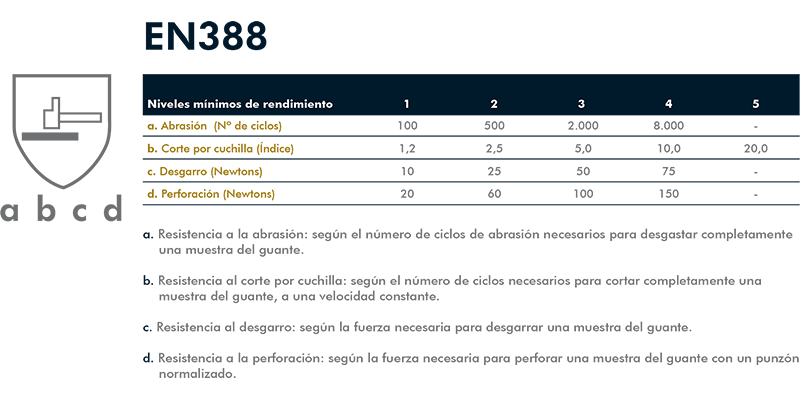
Protection against mechanical risks
STANDARD EN 374-1:2003 (Protective gloves against chemicals and micro-organisms)
This standard specifies the requirements for gloves to protect the user against chemicals and/or micro-organisms and defines terms to be used. This standard should be used in conjunction with EN 420. This standard does not specify requirements for protection against any mechanical hazards.
The performance requirements for gloves protecting against chemicals and/or micro-organisms are as follows:
- Minimum length for being impermeable to liquids.
- Penetration—No leakage.
- Permeation—Each glove is classified in terms of breakthrough time, according to each individual chemical that the glove resists.
- Mechanical characteristics—The performance levels obtained for each of the mechanical tests described in EN 388 must be indicated in the information leaflet.
The marking of the gloves must follow the requirements indicated in EN 420. The appropriate pictogram must be used.
- For gloves meeting the indicated penetration and permeation requirements, the chemical pictogram must be used together with the appropriate code letter.
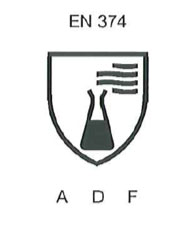
- For waterproof gloves and those with low chemical protection, the following pictogram should be included:
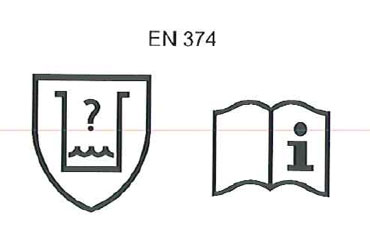
STANDARD EN 455 (Medical gloves for single use)
This European Standard specifies requirements and test methods for single-use medical gloves, i.e. surgical gloves and examination gloves, to ensure that they provide and maintain an adequate level of protection against cross-contamination for both the patient and the user while in use. The standard EN 455 consists of the following parts, under the general heading "single-use medical gloves":
1) Requirements and testing for freedom from holes
2) Requirements and testing for physical properties
3) Requirements and testing for biological evaluation
4) Requirements and testing for shelf life determination.
Body protection
- STANDARD ISO 13688:2013 (Protective clothing – General requirements)
- STANDARD ISO 11612:2008 (Clothing to protect against heat and flame)
- STANDARD EN 340:2003 (Protective clothing)
- STANDARD EN 14605:2005 + A1:2009 (Protective clothing against liquid chemicals)
- STANDARD EN ISO 13982-1:2004 (Protective clothing for use against solid particulates)
- STANDARD EN 13034:2005 + A1:2009 (Protective clothing against liquid chemicals)
- STANDARD EN 1073:1:1998 (Protective clothing against radioactive contamination)
- STANDARD EN 14126:2004 (Protective clothing – Performance requirements and tests methods for protective clothing against infective agents)
- STANDARD EN 1149-5:2008 (Protective clothing – Electrostatic properties)
STANDARD ISO 13688:2013 (Protective clothing – General requirements)
This standard specifies general performance requirements for ergonomics, innocuousness, size designation, ageing, compatibility and marking of protective clothing and the information to be supplied by the manufacturer with the protective clothing.
General marking: each piece of protective clothing must be marked:
- Information written in the official language of the country of destination.
- On the product or on labels attached to the product.
- Affixed in such a way as to be visible and legible.
- Durable according to the expected number of cleaning processes.
Specific marking: must include the following information:
- Name, trademark, or other means of identification for the manufacturer or its authorised representative.
- Designation of product type, trade name, or code.
- Sizing.
- Specific standard number (EN.....).
- If applicable, the pictogram and performance levels.
- Care marking. Washing or cleaning instructions should preferably be indicated according to EN 23758. Maximum number of washings.
- Single-use PPE must be marked with the words "Not reusable".
- With the specific pictogram of each standard, the reference of the ISO 13688 standard must not appear alone; the corresponding standard must also be shown.
STANDARD ISO 11612:2008 (Clothing to protect against heat and flame)
This standard specifies the performance for garments made from flexible materials designed to protect the wearer's body, except the hands, from heat and/or flame. For head and foot protection, the only protective items covered by this international standard are gaiters, hoods, and boot covers.
Among all the risks included in this international standard, there are three levels:
- Level 1 to indicate exposure to a low perceived risk.
- Level 2 to indicate exposure to a moderate perceived risk.
- Level 3 to indicate exposure to a high perceived risk.
For protection against extreme exposure to radiant heat, a fourth level covers the use of high-performance materials such as aluminised fabrics.
This standard covers a wide range of end uses for which performance is indicated by the different indices:
A: Resistance to flame, limited flame propagation tests (A1/A2)
B: Convective heat (levels 1 to 3)
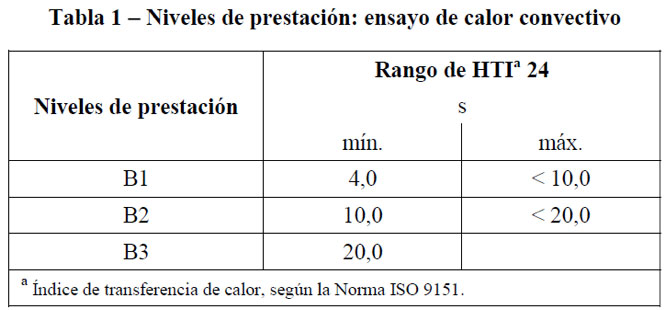
C: Radiant heat (levels 1 to 4)
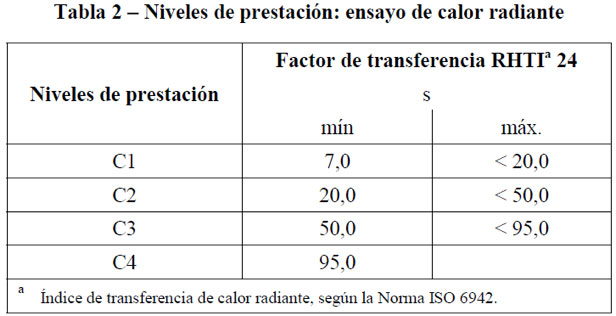
D: Projection of molten aluminium (levels 1 to 3)
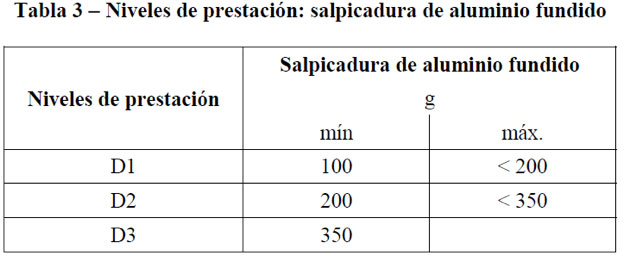
E: Projection of molten iron (levels 1 to 3)
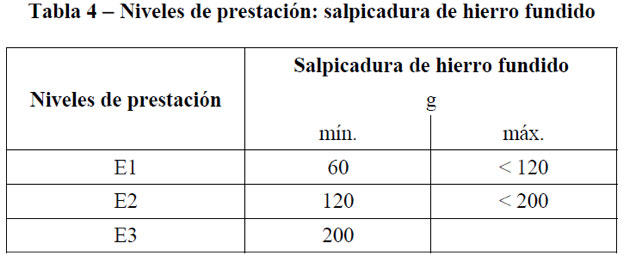
F: Resistance to contact heat
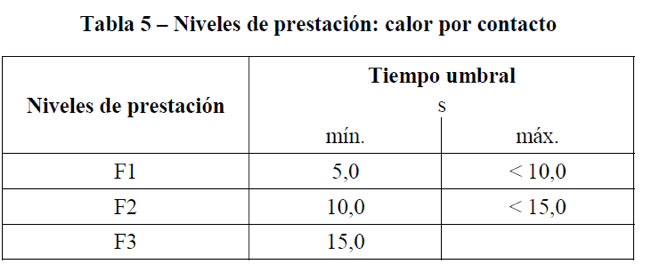
The marking must include the following information:
- It must be marked with the pictogram, including the number and date of this standard, as well as the performance levels achieved.
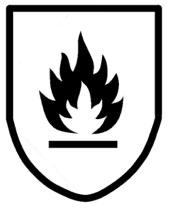
- All garments must be marked with codes A1/A2 and at least one more code—B, C, D, E, or F— followed by a number indicating the performance level achieved.
STANDARD EN 340:2003 (Protective clothing)
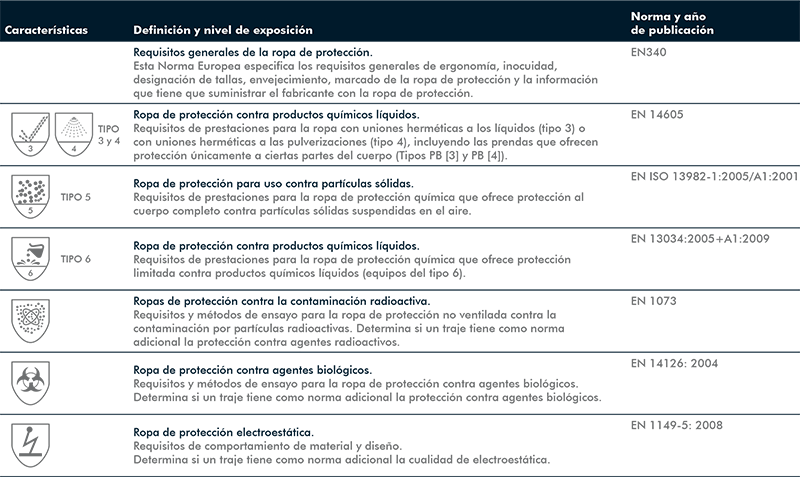
Disposable protection
This standard specifies the general requirements for ergonomics, safety, size designation, ageing, compatibility and marking of protective clothing and the information that the manufacturer must provide with protective clothing. This standard cannot be used alone but only in combination with another standard containing requirements for specific performance of a product in providing protection.
General marking: each piece of protective clothing must be marked with the following information:
- The marking must be visibly and legibly affixed onto the product or on labels attached to the product, and must last according to the intended number of cleaning processes.
- Name, brand, or identification of the manufacturer.
- Designation of the type of product.
- Sizing.
- Number of the specific standard.
- If applicable: the pictogram and performance levels. The pictogram must be used to indicate the type of risk.
- Care instructions.
- Single-use PPE must be marked with the words "Not reusable".
STANDARD EN 14605:2005 + A1:2009 (Protective clothing against liquid chemicals)
This standard specifies the minimum requirements for the following types of limited use and reusable chemical protective clothing:
- Type 3: Liquid-tight clothing.
- Type 4: Spray-tight clothing.
- Partial body protective clothing providing protection to specific parts of the body against the permeation of liquid chemicals (Types PB [3] and PB [4]).
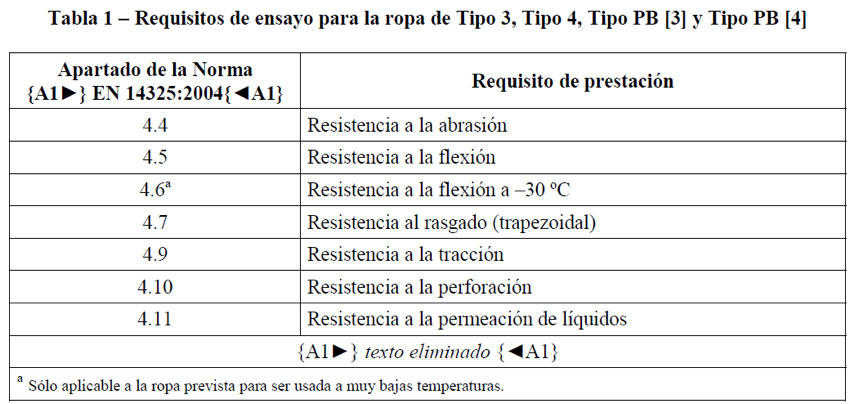
Chemical protective clothing must be marked with at least the following information:
- Brand identification.
- The type of chemical protective clothing, Type 3, Type 4, or Type PB [3] or PB [4].
- The number and date of this document.
- The year and month of manufacture.
- The size range.
- A pictogram indicating that the suit is for protection against chemicals.
- For reusable clothing: care pictograms. For limited use clothing: "Do not reuse".
STANDARD EN ISO 13982-1:2004 (Protective clothing for use against solid particulates)
This part of the standard specifies the performance requirements for chemical protective clothing providing protection to the full body against airborne solid particulates (type 5 clothing). These garments are full-body protective clothing. This part of the Standard is only applicable to airborne solid particles. It is necessary to determine the suitability of Type 5 clothing for each specific chemical and the acceptable exposure limits for each substance regarding inward leakage.
The material must meet the same requirements as those specified in EN 4325 (table in the EN 14605:2005 standard).
Chemical protective clothing must be marked with at least the following information:
- Name or identification of the manufacturer.
- Type, identification, or model number given by the manufacturer.
- Type 5.
- Number and date of publication of this standard.
- Year of manufacture and maximum storage life.
- Sizing.
- Pictogram indicating that the suit is for protection against chemicals.
STANDARD EN 13034:2005 + A1:2009 (Protective clothing against liquid chemicals)
This document specifies the minimum requirements for limited use and re-useable limited performance chemical protective clothing. Limited performance chemical protective clothing is intended for use in cases of a potential exposure to a light spray, liquid aerosols or low pressure, low volume splashes, against which a complete liquid permeation barrier (at the molecular level) is not required. This document covers both chemical protective suits (Type 6) and partial body protection (Type PB [6]).
Chemical protective clothing must be marked with at least the following information:
- Name or identification of the manufacturer.
- Type, identification, or model number given by the manufacturer.
- Type 6 for chemical protective suits, or type PB [6] for clothing protecting only specific parts of the body.
- Number and date of publication of this standard.
- Year of manufacture and maximum storage life.
- Sizing.
- Pictogram indicating that the suit is for protection against chemicals.
STANDARD EN 1073:1:1998 (Protective clothing against radioactive contamination)
This standard specifies the requirements and test methods for ventilated protective clothing protecting the wearer against particulate radio-active contamination. This standard does not apply for the protection against ionizing radiation and the protection of patients against contamination with radioactive substances by diagnostical and/or therapeutical measures.
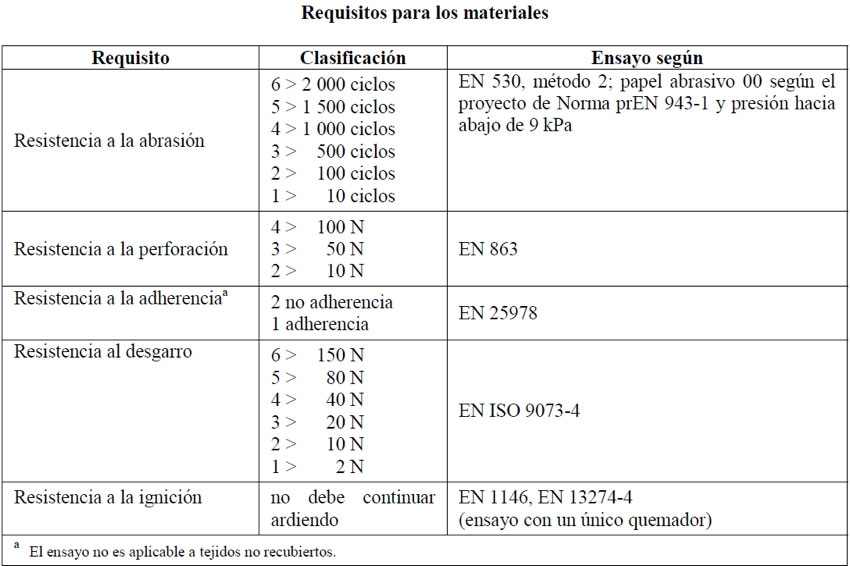
The marking on protective clothing must contain the following information:
- Name or identification of the manufacturer.
- Type, identification, or model number given by the manufacturer.
- Number and date of publication of this standard.
- Year of manufacture.
- Sizing.
- Pictogram shown.

STANDARD EN 14126:2004 (Protective clothing – Performance requirements and tests methods for protective clothing against infective agents)
This standard specifies the requirements and tests methods for protective clothing against infective agents. Protective clothing against infectious agents is designed to protect against biological agents—not only against bacteria, viruses and parasites, but also against sub-viral particles. This type of clothing belongs to Category III of personal protective equipment.
The marking on protective clothing must contain the following information:
- Name or identification of the manufacturer.
- Type, identification, or model number given by the manufacturer.
- Number and date of publication of this standard.
- Year of manufacture.
- Sizing.
- Pictogram shown.
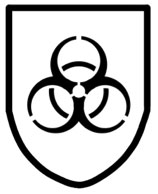
STANDARD EN 1149-5:2008 (Protective clothing – Electrostatic properties)
This European Standard specifies material and design requirements for electrostatic dissipative protective clothing, used as part of a total earthed system, to avoid incendiary discharges. The requirements may not be sufficient in oxygen enriched flammable atmospheres. EN 1149 consists of the following parts, under the general title “Protective clothing — Electrostatic properties”:
- 1) Test method for measurement of surface resistivity;
- 2) Test method for measurement of the electrical resistance through a material (vertical resistance);
- 3) Test methods for measurement of charge decay;
- 4) Garment test (under development);
- 5) Material performance and design requirements.
The marking on protective clothing must contain the following information:
- Name or identification of the manufacturer.
- Type, identification, or model number given by the manufacturer.
- Number and date of publication of this standard.
- Year of manufacture.
- Sizing.
- Pictogram shown.
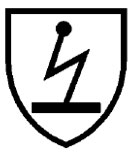
Other protective equipment – Devices / Curtains
STANDARD EN ISO 25980:2014 (Health and safety in welding and allied processes – Transparent welding curtains, strips and screens for arc welding processes)
This international standard specifies safety requirements for transparent welding curtains, strips, and screens to be used for shielding of work places from their surroundings where arc welding processes are used. They are designed to protect people who are not involved in the welding process from hazardous radiant emissions from welding arcs and spatter.
The following requirements must be met:
- Transmittance: In the wavelength range from 400 nm to 1,400 nm, the risk index G must be less than 1.
- Reflectance: the reflection factor between 230 nm and 400 nm must be less than 10%. The light reflectance factor must be less than 10%.
- UV-Stability: The relative variation of the transmission factor in the visible spectrum must not exceed ± 20%.
- Resistance to ignition.
- Eyelet strength.
For properly identifying and using curtains, panels, and welding screens, they must be permanently marked. The marking must be visible, with letters at least 10 mm high. The marking consists of the standard number and the certification mark. The name of the manufacturer and the month and year of manufacture.